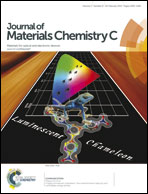High performance nonvolatile transistor memories of pentacene using the electrets of star-branched p-type polymers and their donor–acceptor blends†
Abstract
Pentacene-based nonvolatile field-effect transistor (FET) memory utilizing novel electrets consisting of star-branched p-type polymers, polystyrene para-substituted oligofluorenes (P(StFl)n), and their hybrids with n-type PCBM was demonstrated in this work. As the arm number of P(StFl)n increases, the OFET hole mobility and memory window are improved to 0.69 cm2 V−1 s−1 and 19.75 V, with a high ON/OFF current ratio of over 108. The low dielectric constant of the large arm number of P(StFl)n leads to the greater loaded electric field and results in a large memory window. Moreover, the device performance can be further improved when the p-type star-branched (P(StFl)n) based electrets are blended with n-type PCBM. By precisely controlling the blended concentration of PCBM, the hole mobility of pentacene and the derived memory window could increase to 1.04 cm2 V−1 s−1 and 35.59 V, respectively. Two kinds of mechanism are proposed for P(StFl)n and PCBM:P(StFl)4 based memories, including carrier trapping and tunneling effect under a gate electric field. Our results not only show the potential of the star-branched polymers serving as electrets for FET memory, but also demonstrate the use of donor–acceptor (D–A) hybrid electrets is an efficient strategy to achieve high-performance nonvolatile OFET memories.


 Please wait while we load your content...
Please wait while we load your content...